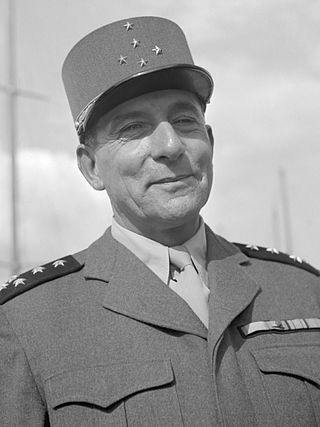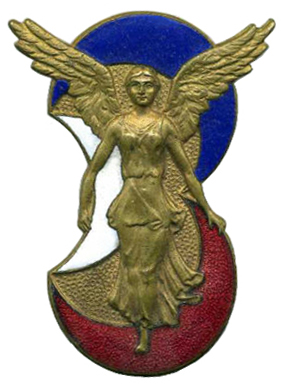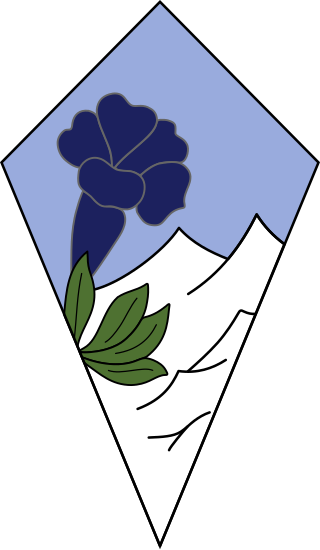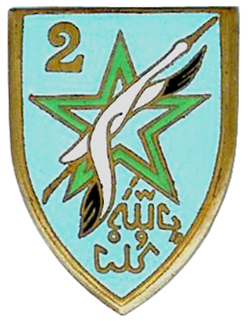
The 6th United States Army Group was an Allied army group that fought in the European Theater of Operations during World War II. Made up of field armies from both the United States Army and the French Army, it fought in France, Germany, Austria, and, briefly, Italy. Also referred to as the Southern Group of Armies, it was established in July 1944 and commanded throughout its duration by General Jacob L. Devers.

Jean Joseph Marie Gabriel de Lattre de Tassigny was a French général d'armée during World War II and the First Indochina War. He was posthumously elevated to the dignity of Marshal of France in 1952.

The First Army was a field army of France that fought during World War I and World War II. It was also active during the Cold War.

The Colmar Pocket was the area held in central Alsace, France, by the German Nineteenth Army from November 1944 to February 1945, against the U.S. 6th Army Group during World War II. It was formed when 6th AG liberated southern and northern Alsace and adjacent eastern Lorraine, but could not clear central Alsace. During Operation Nordwind in December 1944, the 19th Army attacked north out of the Pocket in support of other German forces attacking south from the Saar into northern Alsace. In late January and early February 1945, the French First Army cleared the Pocket of German forces.

The French Forces of the Interior were French resistance fighters in the later stages of World War II. Charles de Gaulle used it as a formal name for the resistance fighters. The change in designation of these groups to FFI occurred as France's status changed from that of an occupied nation to one of a nation being liberated by the Allied armies. As regions of France were liberated, the FFI were more formally organized into light infantry units and served as a valuable manpower addition to regular Free French forces. In this role, the FFI units manned less active areas of the front lines, allowing regular French army units to practice economy of force measures and mass their troops in decisive areas of the front. Finally, from October 1944 and with the greater part of France liberated, the FFI units were amalgamated into the French regular forces continuing the fight on the Western Front, thus ending the era of the French irregulars in World War II.

The Alsace-Lorraine Independent Brigade, usually known as the Alsace-Lorraine Brigade or sometimes as the Brigade Malraux, was a French Forces of the Interior (FFI) unit that fought alongside regular French Army forces in World War II during the closing months of 1944 and early 1945.

Joseph Jean de Goislard de Monsabert, was a French general who served during the Second World War.

Lieutenant General Frank William Milburn was a senior United States Army officer who served during World War II and the Korean War.
The 1st Army Corps was first formed before World War I. During World War II it fought in the Campaign for France in 1940, on the Mediterranean islands of Corsica and Elba in 1943 - 1944 and in the campaigns to liberate France in 1944 and invade Germany in 1945.

The 1st Free French Division was one of the principal units of the Free French Forces (FFL) during World War II, renowned for having fought the Battle of Bir Hakeim.

The French Expeditionary Corps, also known as the French Expeditionary Corps in Italy, was an expeditionary force of the French Liberation Army. Created in 1943, the corps fought in the Italian Campaign of World War II, under the command of General Alphonse Juin. Consisting of 112,000 men divided into four divisions, all but one of the divisions were colonial units, mostly Moroccans and Algerians drawn from the Army of Africa and led by French officers. Overall the Expeditionary Corps was composed of approximately 60 % of colonial troops.

The 3rd Algerian Infantry Division was an infantry division of the Army of Africa which participated in World War II.

The 27th Mountain Infantry Brigade is a mountain infantry formation of the French Army. The brigade is subordinated to the 1st Armored Division and specializes in mountain warfare.
The 4th Army Corps of the French Army was reformed in 1873 at Le Mans under Général Édouard-Jean-Étienne Deligny, after being surrounded and taken prisoner in the siege of Metz (1870).
Jean Raoux was a French général de brigade, who began his career during the Second World War and later fought in Indochina and Algeria.
The Moroccan Division or the 1st Moroccan Division of 1914, initially the Marching Division of Morocco was an infantry division of France's Army of Africa which participated in World War I.

The 4th Moroccan Mountain Division was an infantry division of the Army of Africa which participated in World War II.

The 2nd Moroccan Infantry Division was an infantry division of the Army of Africa which participated in World War II.

The 14th Infantry Division was an infantry division of the French Army which took part in the Napoleonic Wars, the First World War, the Second World War and the Algerian War.
Raymond Emmanuel Marie Siméon Chomel was a French General and leader of the resistance during World War Two.













